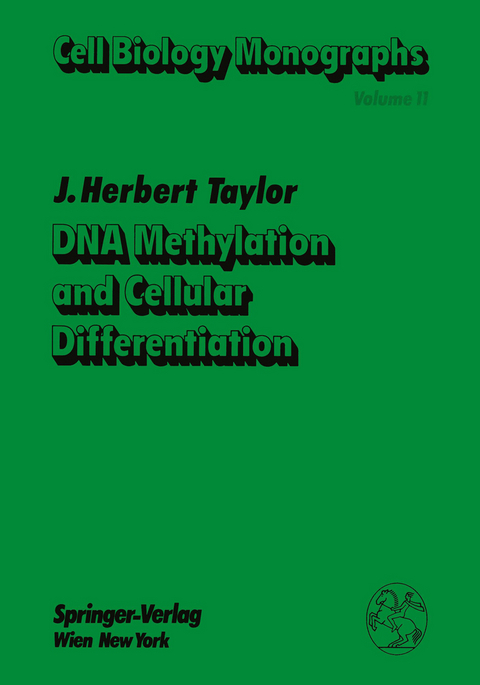
DNA Methylation and Cellular Differentiation
Springer Wien (Verlag)
978-3-7091-8723-4 (ISBN)
I. DNA Methylation and Cell Differentiation: An Overview.- A. Introduction.- B. What New Properties Does Methylation Confer on DNA?.- C. The Origin and Maintenance of Methyl Cytosine in DNA.- D. Differentiation: The Problem Posed.- E. Genome Modifications Which Can Be Associated with Differentiation.- a) Examples of Mobile Genetic Elements in Com.- b) The Discovery of a Mutable Gene.- II. DNA Methylation and Transposable Genetic Elements.- A. Discovery of Enzymatic Methylation of DNA.- B. The First Demonstrated Role of DNA Methylation: Restriction-Modification Systems in Bacteria.- C. Hypotheses for Roles of Methylation in Eukaryotes.- D. Transposable Genetic Elements.- III. Differentiating Systems and Their Methylation Patterns.- A. Differentiation of the Hemopoietic System and Organization of Hemoglobin Genes..- B. Methylation Patterns of Hemoglobin Genes.- C. Differentiation of Lymphocytes and the Role of Methylation.- D. Suppression of Integrated Viral Genomes in Cells by DNA Methylation.- E. The Vitellogenin Genes in Xenopus Are Methylated, But Can Be Expressed Without a Detectable Change in the Pattern.- F. Integrated Retroviruses Are Methylated Early in Development.- G. Suppression of Metallothionein Genes by Methylation.- H. Other Genes That Are Suppressed by Methylation.- I. Correlation Between DNase I Sensitivity of Chromatin änd Cytosine Methylation.- J. The Hpall Sites in an Ovalbumin Gene.- K. The 5' End of the Rat Albumin Gene Is Undermethylated in Cells in Which It Is Expressed.- L. Methylation of Human Growth Hormone and Somatotropin Genes.- M. Methylation of Ribosomal Genes.- IV. DNA Methylation and the Inactive X Chromosome of Mammals.- A. A Brief History of X Chromosome Inactivation Studies.- B. A New Methylation Model.- V. Mechanisms ofSuppression by DNA Methylation.- A. Expression of the Late Viral Protein of SV-40 (VP-1) Is Reduced by Methylation at One Hpall Site.- B. Transcription of a Cloned Adenovirus Gene Is Inhibited by in vitro Methylation.- C. Transcription of a Cloned Human Gamma Globin Gene Is Inhibited by Methylation at the 5' Region Flanking the Structural Gene.- D. The Mechanism by Which Methylated CpG Sites Inhibit Transcription.- E. How Are Methylation Patterns Established and Maintained?.- F. The Specificity of Methylases and the Maintenance of Methylation Patterns.- G. Properties of Eukaryotic Methylases.- H. The Maintenance of Methylation Patterns Imposed in vitro.- I. Deletion of Methylation Patterns Düring Differentiation.- VI. Evolution, Stability and Regulation of Methylation Patterns.- A. The Evolutionary Aspects of DNA Methylation.- B. DNA Methylation and Repair.- C. How Stable Is a Pattern of Methylation?.- D. Overview on the Role of DNA Methylation.- E. An Hypothesis for the Control of Methylation Patterns.- F. A Pyramid of Controls in Vertebrate Cells.- References.
| Erscheint lt. Verlag | 30.12.2011 |
|---|---|
| Reihe/Serie | Cell Biology Monographs |
| Zusatzinfo | VIII, 138 p. |
| Verlagsort | Vienna |
| Sprache | englisch |
| Maße | 170 x 244 mm |
| Gewicht | 274 g |
| Themenwelt | Mathematik / Informatik ► Informatik ► Datenbanken |
| Naturwissenschaften ► Biologie ► Biochemie | |
| Naturwissenschaften ► Biologie ► Zellbiologie | |
| Schlagworte | cell differentiation • cellular differentiation • Desoxyribonukleinsäure • DNA • methylation • Methylierung • Nucleic acid • Zelldifferenzierung |
| ISBN-10 | 3-7091-8723-0 / 3709187230 |
| ISBN-13 | 978-3-7091-8723-4 / 9783709187234 |
| Zustand | Neuware |
| Haben Sie eine Frage zum Produkt? |
aus dem Bereich


